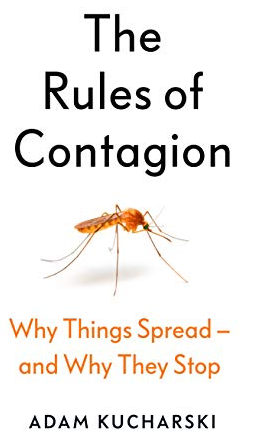A timely study on how contagions spread in the world
A timely book on why things, including viruses, spread in the world and how to stop them. Although Adam Kucharski, a mathematician and an associate professor at the London School of Hygiene and Tropical Medicine, doesn’t address specifically the coronavirus COVID-19, you’ll learn how to think about pandemics and spread of diseases. And if you’re worried about what modern life has in stock for you, including the coronavirus COVID-19, this books has lots of insights and answers. In short, the book explains how things including ideas, diseases, viral news, folks stories, financial crises, loneliness, crime, obesity, social media and misinformation spread in the world.
The spread of things is influenced by four factors such as
Duration
Opportunities
Transmission
Susceptibility
or DOTS for short, says Kucharski. These factors affect the reproduction number or R and allow us to calculate how fast a disease or other things could spread and be stopped from spreading. Reducing one or all four factors will reduce the spread of a virus, for example. So quarantine and self-isolation work because they reduce the ‘opportunities’ factor. But with social media or viral marketing/content or desire to “own the internet” (the title of one of the chapters), you want to push the R factors, not reduce them. Please like this blog via twitter and Facebook below.
What about the coronavirus COVID-19?
The book was written before the outbreak of the coronavirus COVID-19 but published at the critical time (he cracks masterfully chance, risk, decision-making, luck and gambling or watch Adam’s talk below) when we need to know as much as possible how to deal with possible pandemics. In an interview for The Sunday Times paper, he suggests a few things that might minimise your exposure to the virus. Think twice before visiting A&E because “the transmission data shows similarities with the Sars epidemic: there were a lot of super-spreading events around healthcare and hospitals, and we’re seeing that the Covid-19 too. We’re also seeing early indications of a lot of transmission in household settings and gatherings. We’ve found nine or 10 examples, barbecue and that kind of thing, where a large proportion of people there get infected.” In the book, he quotes that on average in the UK, people have five contacts a day (but in Italy, the number is 10/day), so perhaps go for elbow-bumps instead of handshakes and keep buttoned-up British reserve to save us.
It’s a race
“The question with any new outbreak is whether collaboration is enough to outpace contagion.” states Kucharski, summing up the challenge for the coronavirus COVID-19 – it’s a race. Time is of the essence with potential pandemics because of the exponential early growth and if you catch them in a few weeks, it makes a big difference later. Joshua Lederberg, the Noble Prize-winning biologist states it more bluntly, “The single biggest threat to man’s continued dominance on this planet is the virus.” This is echoed by Steven Chu, head of the American Association for the Advancement of Science, who when asked about coronavirus, reminded us about H5N1 avian/bird flu virus (that occurred and still occurring in chicken farms south of Wuhan) that has learnt to infect humans but not yet how to spread from human to human and that has 60% mortality rate. Pale Rider in her book The Spanish Flu of 1918 and How it Changed the World, suggests that in the past, pandemics receded even if humans didn’t intervene because the virus either kills those it infects or leaves them more or less immune. That was the case with Spanish flu which was left to run its course (killing at least 50 million people worldwide) because governments and doctors were helpless. Jonathan Quick, of Duke University in South Carolina, author of The End of Epidemics: The Looming Threat to Humanity and How to Stop it, agrees that “Judging by past experiences, however, it’s likely that health officials and the public in much of the world remains unaware or unconvinced of the danger this virus poses.” and that “The worst-case scenario is looking increasingly likely.”
R = Duration x Opportunities x Transmission probability x Susceptibility
To sum up
If your interest in this book is because of the Covid-19 virus – the winning strategy is simple: limit your personal interactions (R factors) to zero and you’ll be safe. So staying alone at home reading slowly this book might be a good idea but because we don’t really know for how long it will develop and last (Kucharski says, “If you’ve seen one pandemic, you’ve seen… one pandemic”) – get some longer books to read (slowly – not speed read:) such as War and Peace, and trilogies. And of course, take all other common-sense measures to protect yourself.
And please do click and like this summary on twitter and Facebook handle below – help to spread the good and useful information.
Get Kindle or paperback of The Rules of Contagion: Why Things Spread – and Why They Stop by Adam Kucharski
Watch Adam Kucharski summarising his book previous book The Perfect Bet: Taking the Luck out of Gambling

